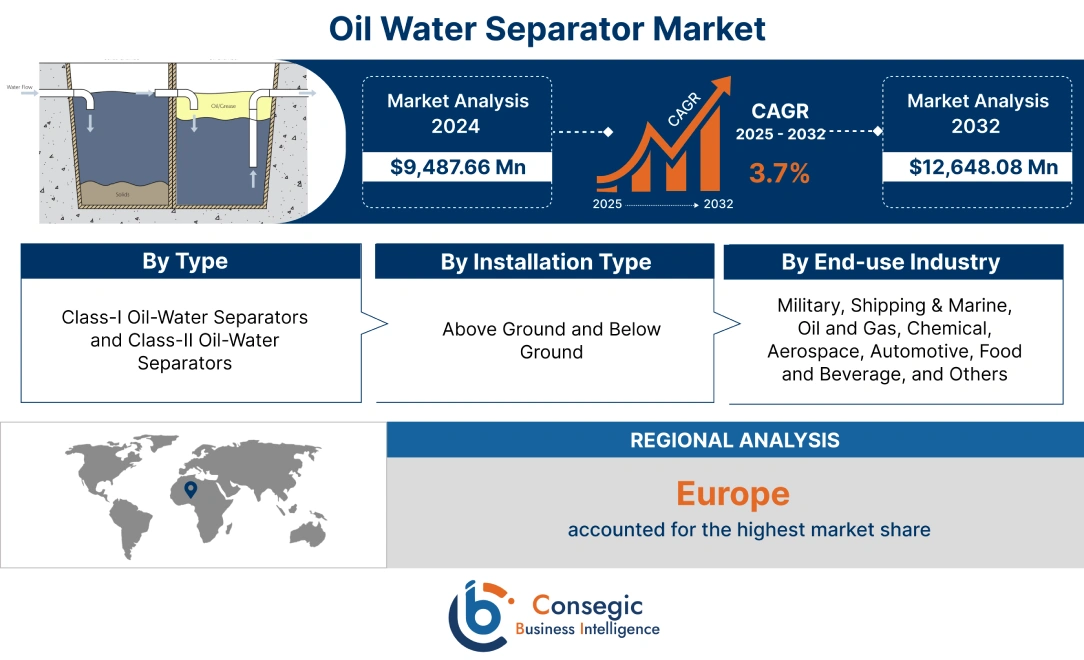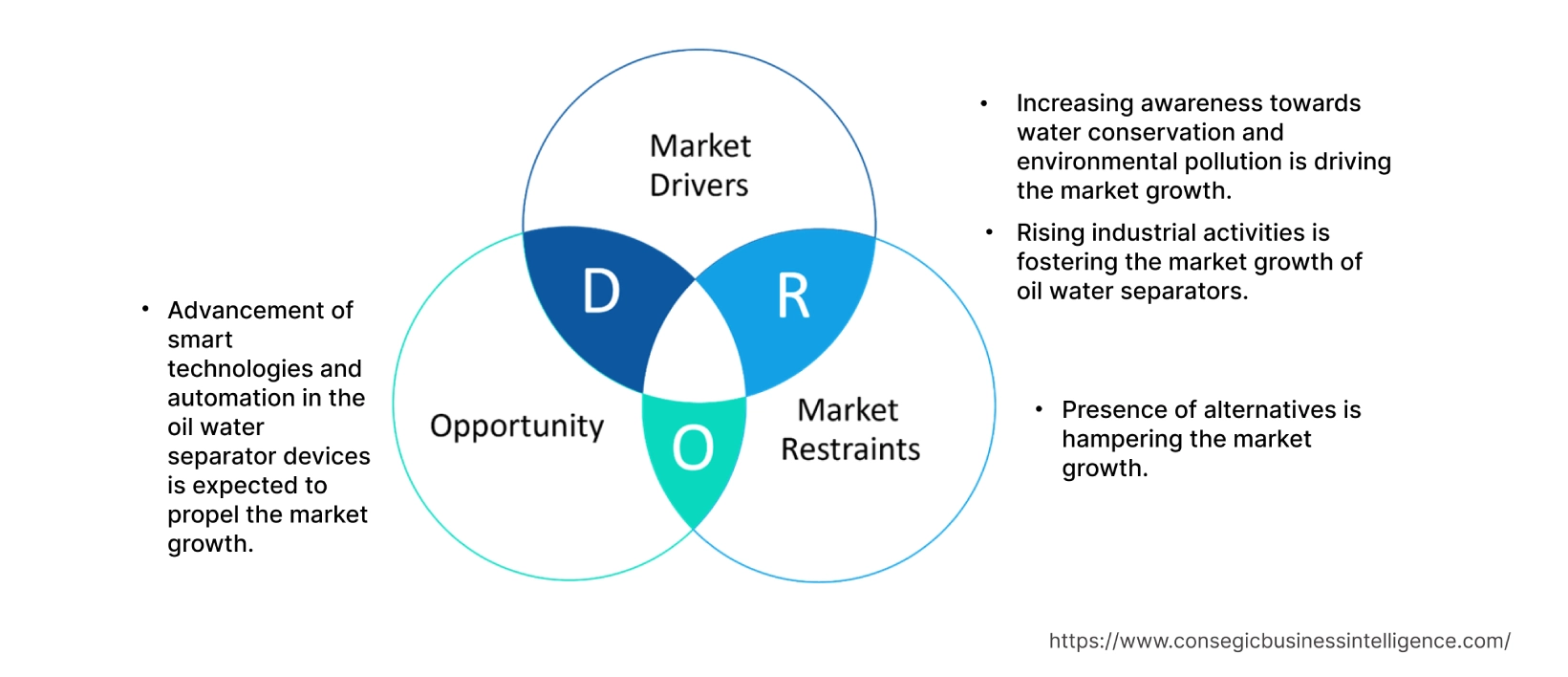Oil Water Separator Market Size :
Consegic Business Intelligence analyzes that the oil water separator market size is growing with a CAGR of 3.7% during the forecast period (2025-2032), and the market is projected to be valued at USD 12,648.08 Million by 2032 from USD 9,487.66 Million in 2024.
Oil Water Separator Market Scope & Overview:
An Oil Water Separator (OWS) is a device that separates oil and water mixtures into their separate components. There are many different types of oil-water separators. Each has a different oil separation capability and is used in different industries. They are designed and selected after consideration of oil separation performance parameters and life cycle cost considerations. These separators treat different contaminants such as emulsified oil, floating oil, dissolved oil, and others. They provide efficient solutions, reduce costs in operations, and improve overall operations in industrial facilities.
Oil Water Separator Market Insights :
Oil Water Separator Market Dynamics - (DRO) :
Key Drivers :
Increasing awareness of water conservation and environmental pollution is driving the market.
Oil water separators (OWSs) are an important part of water conservation and environmental pollution prevention. They help to prevent oil from entering waterways, where it can pollute water bodies and harm wildlife. Rising awareness of environmental pollution and increasing concern for water conservation have forced industries and governments to take up sustainable initiatives to stay aligned with environmental protection and CSR goals. They play a significant role in mitigating oil and hydrocarbons from water, thus protecting aquatic life. Increasing government regulations for sustainability and controlling water pollution has been driving the market. For instance, different government regulations and programs for the conservation of water in India such as the National River Conservation Programme, Atal Mission for Rejuvenation and Urban Transformation, National Lake Conservation Programme, and Smart Cities Mission are driving the oil water separator market growth as the separator devices meet environment compliance standards and are useful in protecting the water system, and the aquatic life.
Rising industrial activities are fostering the market
Increasing industrial activities and generation of industrial wastewater which contains oils and hydrocarbons has led to increased usage of oil water separators. These separators are useful in treating the wastewater to remove oil and pollutants before reuse. Rising industrial activities across different sectors such as petrochemicals, refinery, oil and gas, and automotive, are driving the need for wastewater treatment, and pollution control. They are widely used to mitigate environmental concerns such as ecosystem disruption, and water pollution. Hence growing industrialization activities globally is driving the need for water management, and thus is one of the significant factors for increasing the oil water separator market. For instance, in 2023, according to a stat by the Department of Chemicals & Petrochemicals, the industry of chemicals and petrochemicals in India has grown at a CAGR of 4.6% from 2021 to 2022 and exports of chemical products have accounted for a CAGR rate of 13.9% from 2021 to 2022. Hence, the market trends analysis shows that due to growing industrialization across the globe, the oil water separator market growth is experiencing a significant drive.
Key Restraints :
Presence of alternatives is hampering the market
Flocculation is a method of oil and water separation that uses recycled additives to enhance the separation of oil. It is a process where a chemical coagulant is added to water, which helps in facilitating bonding between particles. This method has wide applications in water clarification, solid removal, sludge thickening, and others. Also, the bioinspired oil water separation process is another substitute for this market. This separation process is a sustainable way to remove the oil and other contaminants from the oil and water mixture. Hence, the analysis of market trends shows that the rising demand for substitutes of oil water separator devices is hampering the oil water separator market demand.
Future Opportunities :
Advancement of smart technologies and automation is expected to propel the market
Artificial intelligence combined with advanced sensors in these devices helps in real-time monitoring and provides enhanced accuracy and responsiveness. These advanced products also help in less consumption of energy and provide greater efficiency in oil removal. Also, automation leads to cost savings and mitigates the manual labor involved. Thus, technologically advanced product launches by the oil and water separator manufacturers are expected to propel the market over the forecast period. For instance, in February 2023, Alfa Laval launched an advanced oil water separator product named PureBilge Compact which is known for easy installation, reduction of operating cost, and is one of the sustainable products. Hence, analysis of market trends depicts that the wide product development and advancement are boosting the oil water separator market opportunities.
Oil Water Separator Market Report Insights :
| Report Attributes | Report Details |
| Study Timeline | 2019-2032 |
| Market Size in 2032 | USD 12,648.08 Million |
| CAGR (2025-2032) | 3.7% |
| By Type | Class-I Oil-Water Separators and Class-II Oil-Water Separators |
| By Installation Type | Above Ground and Below Ground |
| By End-use Industry | Military, Shipping & Marine, Oil and Gas, Chemical, Aerospace, Automotive, Food and Beverage, and Others |
| By Region | North America, Europe, Asia-Pacific, Latin America, and Middle East & Africa |
| Key Players | Alfa Laval AB, Andritz AG, Siemens AG, Parker-Hannifin Corporation, Wärtsilä Oyj Abp, Donaldson Company, Inc., Mercer International Inc., ZCL Composites, HSN-Kikai Kogyo, and Highland Tank |
Oil Water Separator Market Segmental Analysis :
By Type :
The type segment is bifurcated into class-I oil-water separators and class-II oil-water separators. In 2024, the class-II oil-water separators segment accounted for the highest market share of the global oil water separator market and is expected to grow at the fastest CAGR during the forecasted period. They achieve a concentration of less than 100 mg/l and are efficient in cleaning water by removing oil contaminants before being let out to passes and foul sewers. Certain advantages of this product type include large capacity and durability which has been driving the majority of demand for the class-II. Also, the wide application of the product in gas stations, bus garages, container terminals, helipads, military hangars, truck yards, and others showcases high demand for this product. Hence, analysis of segment trends depicts that due to the aforementioned factors, the class-II separators segment has been experiencing positive oil water separator market demand.
By Installation Type :
The installation type segment is bifurcated into the above-ground and below-ground. In 2024, the above-ground segment accounted for the highest market of the total oil water separator market share and is expected to grow at the fastest CAGR in the market. The maintenance of above-ground separators involves just washing them out with a hose and a pressure washer, or with removable vapor-tight covers. Thus, these product has low operational cost and maintenance and are known for removing non-emulsified oil and settleable solids from the waste stream. Also, the above-ground separators have wide applications in oil production plants, mining operations, transportation, gasoline stations, automotive repair workshops, and others. Hence, the segment trends analysis shows that due to the aforementioned advantages, the above-ground segment has been experiencing a significant rise in oil water separator market trends.
By End-Use-Industry :
The end-use industry segment is categorized into military, shipping & marine, oil and gas, chemical aerospace, automotive, food and beverage, and others. In 2024, the shipping & marine segment accounted for the highest market share of 28.75% of the total oil water separator market share. The rising development of the global shipping sector is having a direct positive impact on the oil water separator market opportunities. It is largely used in the marine and shipping sectors for the removal of harmful pollutants from the oceans. Also, these devices prevent any kind of oil leak from machinery such as diesel generators, air compressors, and propulsion engines in the marine sector. Hence, due to the advantages of the device such as the protection of aquatic life and mitigation of water pollution, it has wide usage and demand across the shipping and marine sector.
Moreover, the food and beverage segment is expected to grow at the fastest CAGR in the global oil water separator market during this forecast period. Wastewater and oil contaminants are widely generated in the food sector during processes such as packaging, processing, and storing. Thus, it becomes essential to mitigate the contaminants in water to reduce environmental pollution. They play an essential role in the mitigation of contaminants generated due to the food production process. Moreover, the rising food sector globally is serving a direct positive growth impact on the oil water separator market. For instance, according to a recent stat by Invest India, in 2022, the average annual growth rate of the food processing sector in the last 5 years has been around 8.3%. The food processing sector in India is also expected to grow at a CAGR of 15.2% by 2025. Hence, the segmental analysis shows that due to the growing food process sector globally has significant segmental growth.
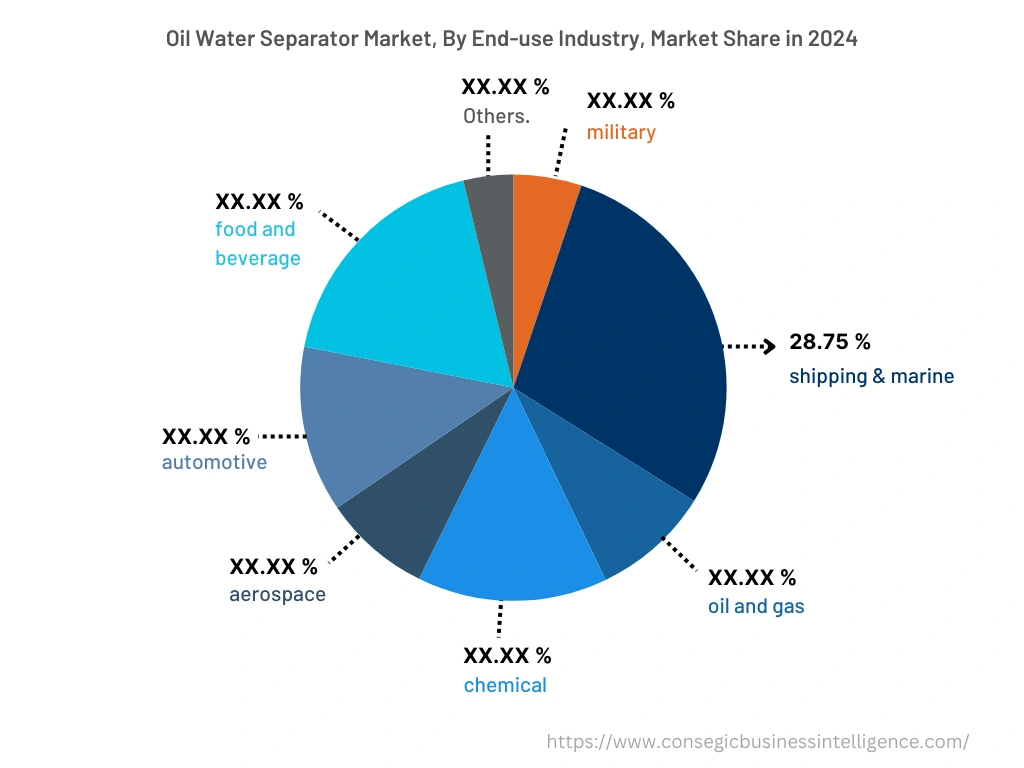
By Region :
The regional segment includes North America, Europe, Asia Pacific, Middle East and Africa, and Latin America.
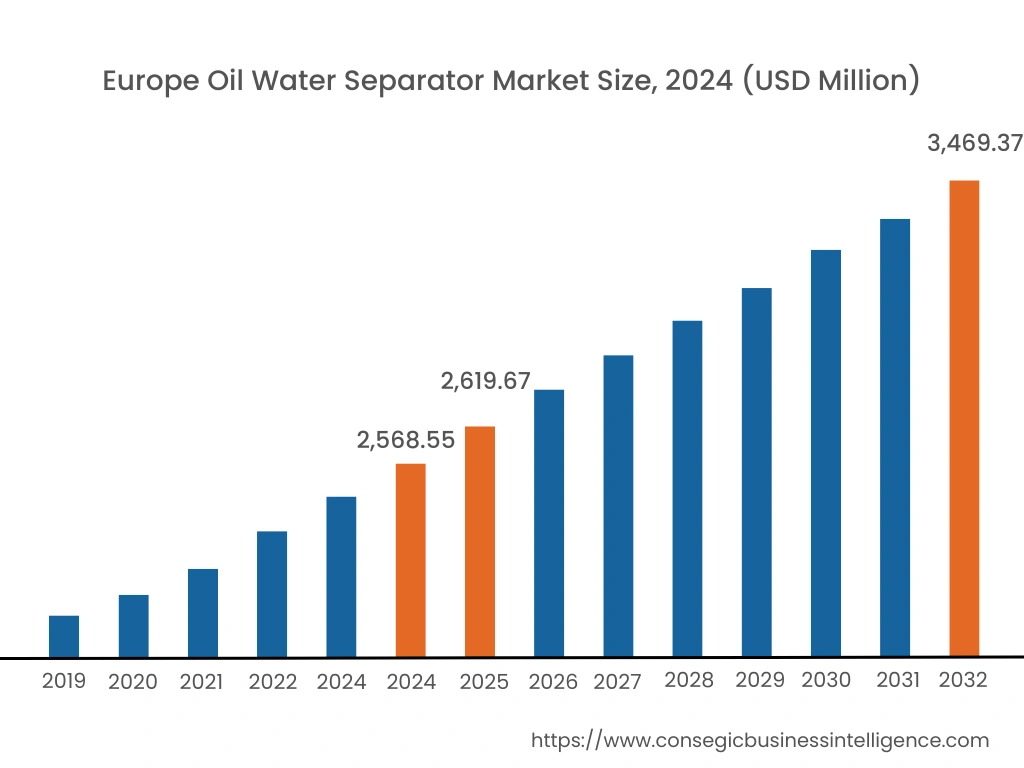
In 2024, Europe accounted for the highest market stake at 36.75% valued at USD 2,568.55 million, and is expected to reach USD 3,469.37 million in 2032. In Europe, Germany accounted for the highest market share of 22.30% during the base year of 2024. As per the oil water separator market analysis, the increasing industrial activities due to rising urbanization in Europe are increasing the demand for separators globally. For instance, according to a recent publication in 2023 by Deutschland.de, in Germany, industrialization is the foundation of economic growth, where around 26.6% was the share of gross value added by the manufacturing sector in 2021, as compared to 16.8% in France. The report also mentions that there are four industries, namely automotive, chemical, mechanical, and electrical, which are contributing majorly to the growing manufacturing sector in Germany. Hence, the regional trends analysis shows that due to the increasing industrial growth in the region, the oil water separator market trends are experiencing a significant rise.
However, Asia Pacific is expected to witness significant growth over the forecast period, growing at a CAGR of 4.10% during 2025-2032. This is due to advancements in technology and increasing spending on R&D activities by the key players in this region. Also, the increasing food and beverage sector, marine sector, among others is acting as a catalyst for the oil water separator market expansion in this region. According to an article by Fi Global, the food and beverage sector in India is rapidly growing due to urbanization and the increasing young population.
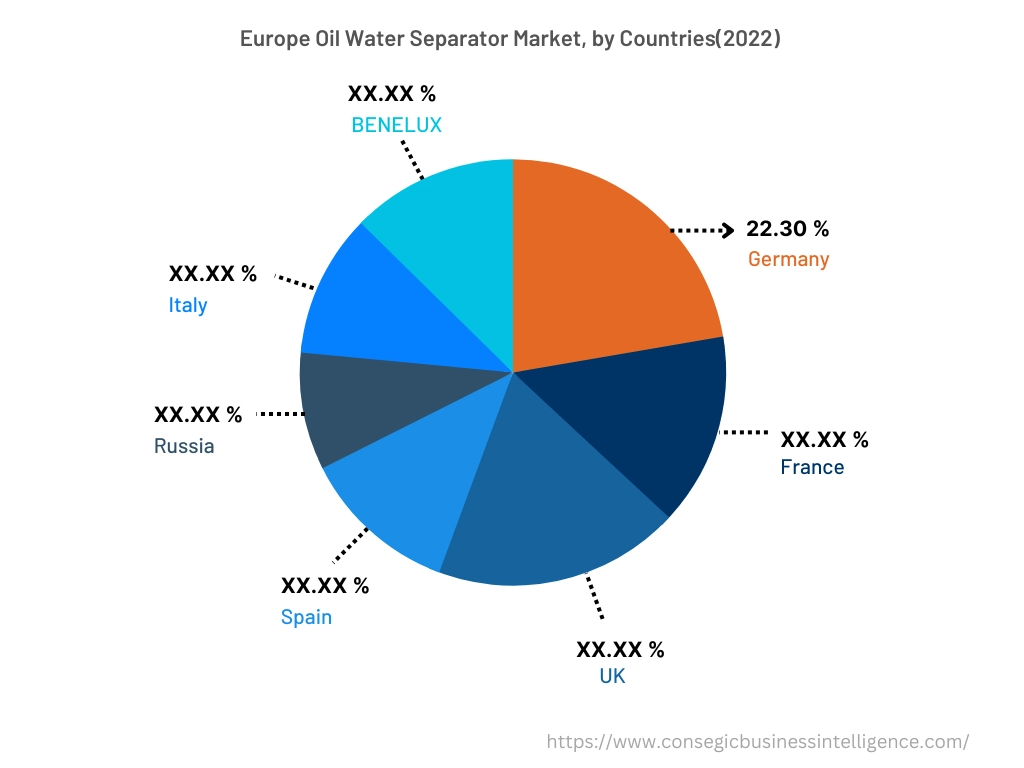
Top Key Players & Market Share Insights:
The Oil Water Separator market is highly competitive, with several large players and numerous small and medium-sized enterprises. These companies have strong research and development capabilities and a strong presence in the market through their extensive product portfolios and distribution networks. The market is characterized by intense competition, with companies focusing on expanding their product offerings and increasing their market stake through mergers, acquisitions, and partnerships. The key players in the oil water separator industry include-
- Alfa Laval AB
- Andritz AG
- ZCL Composites
- HSN-Kikai Kogyo
- Highland Tank
- Siemens AG
- Parker-Hannifin Corporation
- Wärtsilä Oyj Abp
- Donaldson Company, Inc.
- Mercer International Inc.
Recent Industry Developments :
- In July 2023, Andritz introduced its range of three-phase decanter centrifuges for oil recovery. These products are capable of separating both liquid from solid and liquid with different densities such as oil and water. This marks an innovative and smart solution for separating oil from water.
- In July 2021, Donaldson Company, Inc. launched a new product, named Filter Minder Connect solution. This product has features such as high density, dielectric constant, and dynamic viscosity, and weighs five times less than other sensors.
Key Questions Answered in the Report
What was the market size of the oil water separator industry in 2024? +
In 2024, the market size of oil water separator was USD 9,487.66 million.
What will be the potential market valuation for the oil water separator industry by 2032? +
In 2032, the market size of oil water separator will be expected to reach USD 12,648.08 million.
What are the key factors driving the growth of the oil water separator market? +
Increasing awareness towards water conservation and environmental pollution is driving the market growth of the oil water separator market.
What is the dominating segment in the oil water separator market by end-use industry? +
In 2024, the shipping & marine segment accounted for the highest market share of 28.75% in the overall oil water separator market.
Based on current market trends and future predictions, which geographical region is the dominating region in the oil water separator market? +
Europe accounted for the highest market share in the overall oil water separator market.
